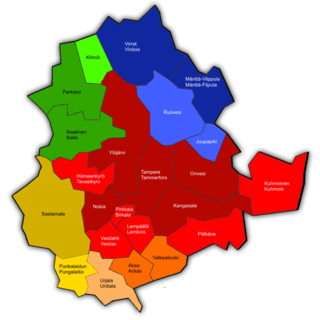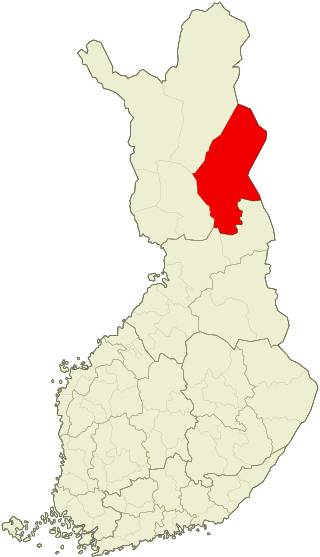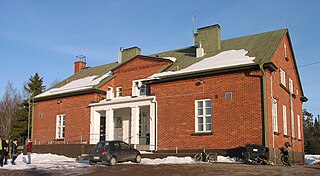
Kauniainen is a small town and a municipality of 10,184 inhabitants in the Helsinki Metropolitan Area in Uusimaa, Finland. It is surrounded and enclaved by the City of Espoo, in the Capital Region of Greater Helsinki. Kauniainen was founded by a corporation in 1906, AB Grankulla, that parcelled land and created a suburb for villas; Kauniainen received the status of a market town in 1920, the Finnish name in 1949 and the title of kaupunki in 1972.

Rauma is a town and municipality of around 38,800 inhabitants on the west coast of Finland, 92 kilometres (57 mi) north of Turku, and 50 kilometres (31 mi) south of Pori. Its neighbouring municipalities are Eura, Eurajoki, Laitila and Pyhäranta. Granted town privileges on 17 April 1442, Rauma is known for its paper and maritime industry, high quality lace and the old wooden architecture of the city centre, which is a UNESCO World Heritage Site.

Nykarleby is a town and municipality of Finland. It is located in the Ostrobothnia region. The municipality is bilingual, with the majority speaking Swedish (0%) and the minority Finnish (0%).

Pirkanmaa, also known as Tampere Region in government documents, is a region of Finland. It borders the regions of Satakunta, South Ostrobothnia, Central Finland, Päijät-Häme, Kanta-Häme and Southwest Finland. Most of the water area in the Kokemäki River watershed is located in the Pirkanmaa region, although Lake Vanajavesi is partly in the Kanta-Häme region. The region got its name from Pirkkala, which in the Middle Ages comprised most of present-day Pirkanmaa. Tampere is the regional center and capital of Pirkanmaa, and at the same time the largest city in the region.

Serbian diaspora refers to Serbian emigrant communities in the diaspora. The existence of a numerous diaspora of Serbian nationals is mainly a consequence of either economic or political reasons.

Ylöjärvi is a town and a municipality in the Pirkanmaa region, 14 kilometres (9 mi) northwest of Tampere and 189 kilometres (117 mi) north of the capital city Helsinki in Finland. The town has a population of 33,719 and covers an area of 1,324.14 square kilometres (511.25 sq mi) of which 208.62 km2 (80.55 sq mi) is water. The population density is 30.22 inhabitants per square kilometre (78.3/sq mi).

The two main official languages of Finland are Finnish and Swedish. There are also several official minority languages: three variants of Sami, as well as Romani, Finnish Sign Language and Karelian.
Vietnamese people in Finland form one of the country's largest groups of Southeast Asian people. According to Statistics Finland, in 2017 there are 10,817 people with a Vietnamese background, 9,872 people whose mother tongue is Vietnamese, 8,012 people who have been born in Vietnam, and 5,603 people with Vietnamese citizenship residing in Finland. The Vietnamese-Finnish community includes both ethnic Vietnamese and Sino-Vietnamese.

Larsmo is a municipality of Finland, located in the Ostrobothnia, alongside the Gulf of Bothnia.

Eastern Lapland is a subdivision of Finnish Lapland and one of the sub-regions of Finland since 2009.

North Eastern Savonia or Northeastern Savo is a sub-region of Finland. It is an administrative subdivision of the region of North Savo.
Monoethnicity is the existence of a single ethnic group in a given region or country. It is the opposite of polyethnicity.
Estonians in Finland or Finnish Estonians are people with an ethnic Estonian background residing in Finland. In 2017, there were 52,424 Estonian immigrants in Finland, according to the UN. Estonians are Finland's second largest immigrant group, after Russians.
Norwegians in Finland are immigrants born in Norway, citizens of Norway or speakers of the Norwegian language living in Finland.
Dutch people in Finland are immigrants from the Netherlands living in Finland. They numbered around 2,000 in 2017 and live mainly in the cities of Helsinki and Espoo.
Chileans in Finland are people from Chile residing in Finland.
Finnish Iranians or Iranian Finns or Iranians in Finland are Finns of Iranian heritage.

Sälinkää is a village in the Mäntsälä municipality in Uusimaa, Finland, with over 200 inhabitants. It is located 11 kilometres (6.8 mi) northwest of the Mäntsälä's municipal centre and 17 kilometres (11 mi) southeast of Oitti, the municipal centre of Hausjärvi. The north-south road 1471 from Hausjärvi to Mäntsälä passes through the village. Lake Kilpijärvi is located near Sälinkää.

Pusula is a village in the city of Lohja in Uusimaa, Finland. It was former administrative center of the former Pusula municipality. It has over 700 inhabitants. Lake Pusula is located on the southern edge of the village.

Vesanka is a village and a district of Jyväskylä, Finland. Before 2009, it was one of the villages of Jyväskylän maalaiskunta. It is located in the far western part of Jyväskylä near its borders with Petäjävesi, Muurame and, until 2009, Korpilahti.















